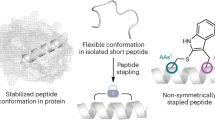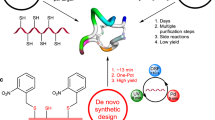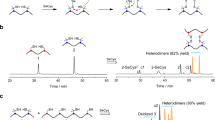Abstract
Multicyclic peptides are emerging as an exciting platform for drug and targeted ligand discovery owing to their expected greater target affinity/selectivity/stability versus linear or monocyclic peptides. However, although the precise pairing of cysteine residues in proteins is routinely achieved in nature, the rational pairing of cysteine residues within polypeptides is a long-standing challenge for the preparation of multicyclic species containing several disulfide bridges. Here, we present an efficient and straightforward approach for directing the intermolecular and intramolecular pairing of cysteine residues within peptides using a minimal CXC motif. Orthogonal disulfide pairing can be exploited in complex redox media to rationally produce dimeric peptides and bi/tricyclic peptides from fully reduced peptides containing 1–6 cysteine residues. This strategy, which does not rely on extensive manipulation of the primary sequence, post-translational modification or protecting groups, should greatly benefit the development of multicyclic peptide therapeutics and targeting ligands.
This is a preview of subscription content, access via your institution
Access options
Subscribe to this journal
Receive 12 print issues and online access
$259.00 per year
only $21.58 per issue
Buy this article
- Purchase on Springer Link
- Instant access to full article PDF
Prices may be subject to local taxes which are calculated during checkout




Similar content being viewed by others
References
Hamada, Y. & Shioiri, T. Recent progress of the synthetic studies of biologically active marine cyclic peptides and depsipeptides. Chem. Rev. 105, 4441–4482 (2005).
White, C. J. & Yudin, A. K. Contemporary strategies for peptide macrocyclization. Nature Chem. 3, 509–524 (2011).
Nikiforovich, G. V., Kövér, K. E., Zhang, W-J. & Marshall, G. R. Cyclopentapeptides as flexible conformational templates. J. Am. Chem. Soc. 122, 3262–3273 (2000).
Haubner, R. et al. Structural and functional aspects of RGD-containing cyclic pentapeptides as highly potent and selective integrin αVβ3 antagonists. J. Am. Chem. Soc. 118, 7461–7472 (1996).
Walensky, L. D. et al. Activation of apoptosis in vivo by a hydrocarbon-stapled BH3 helix. Science 305, 1466–1470 (2004).
Alegre-Cebollada, J., Kosuri, P., Rivas-Pardo, J. A. & Fernández, J. M. Direct observation of disulfide isomerization in a single protein. Nature Chem. 3, 882–887 (2011).
Mamathambika, B. S. & Bardwell, J. C. Disulfide-linked protein folding pathways. Annu. Rev. Cell Dev. Biol. 24, 211–235 (2008).
Sevier, C. S. & Kaiser, C. A. Formation and transfer of disulphide bonds in living cells. Nature Rev. Mol. Cell Biol. 3, 836–847 (2002).
Heinis, C., Rutherford, T., Freund, S. & Winter, G. Phage-encoded combinatorial chemical libraries based on bicyclic peptides. Nature Chem. Biol. 5, 502–507 (2009).
Wong, C. T. T. et al. Orally active peptidic bradykinin B1 receptor antagonists engineered from a cyclotide scaffold for inflammatory pain treatment. Angew. Chem. Int. Ed. 51, 5620–5624 (2012).
Hiruma-Shimizu, K. et al. Chemical synthesis, folding, and structural insights into O-fucosylated epidermal growth factor-like repeat 12 of mouse notch-1 receptor. J. Am. Chem. Soc. 132, 14857–14865 (2010).
Wu, Z. et al. Engineering disulfide bridges to dissect antimicrobial and chemotactic activities of human beta-defensin 3. Proc. Natl Acad. Sci. USA 100, 8880–8885 (2003).
Clark, R. J. et al. The engineering of an orally active conotoxin for the treatment of neuropathic pain. Angew. Chem. Int. Ed. 49, 6545–6548 (2010).
Rauschenberg, M., Bomke, S., Karst, U. & Ravoo, B. J. Dynamic peptides as biomimetic carbohydrate receptors. Angew. Chem. Int. Ed. 49, 7340–7345 (2010).
Cheng, Z., Zhang, J., Ballou, D. P. & Williams, C. H. Reactivity of thioredoxin as a protein thiol–disulfide oxidoreductase. Chem. Rev. 111, 5768–5783 (2011).
Woycechowsky, K. J. & Raines, R. T. The CXC motif: a functional mimic of protein disulfide isomerase. Biochemistry 42, 5387–5394 (2003).
Sando, S., Narita, A. & Aoyama, Y. A facile route to dynamic glycopeptide libraries based on disulfide-linked sugar-peptide coupling. Bioorg. Med. Chem. Lett. 14, 2835–2838 (2004).
Derewenda, U. et al. Structure and function of Bacillus subtilis YphP, a prokaryotic disulfide isomerase with a CXC catalytic motif. Biochemistry 48, 8664–8671 (2009).
Zhang, R. & Snyder, G. H. Kinetics of disulfide exchange-reactions of monomer and dimer loops of cysteine valine cysteine peptides. Biochemistry 27, 3785–3794 (1988).
Lutolf, M. P., Tirelli, N., Cerritelli, S., Cavalli, L. & Hubbell, J. A. Systematic modulation of Michael-type reactivity of thiols through the use of charged amino acids. Bioconjugate Chem. 12, 1051–1056 (2001).
Wu, C., Belenda, C., Leroux, J-C. & Gauthier, M. A. Interplay of chemical microenvironment and redox environment on thiol–disulfide exchange kinetics. Chem. Eur. J. 17, 10064–10070 (2011).
Gasteiger, E. et al. ExPASy: the proteomics server for in-depth protein knowledge and analysis. Nucleic Acids Res. 31, 3784–3788 (2003).
Rostene, W., Kitabgi, P. & Parsadaniantz, S. M. Opinion—Chemokines: a new class of neuromodulator? Nature Rev. Neurosci. 8, 895–904 (2007).
Schmidt, B. V. K. J., Fechler, N., Falkenhagen, J. & Lutz, J. F. Controlled folding of synthetic polymer chains through the formation of positionable covalent bridges. Nature Chem. 3, 234–238 (2011).
Craik, D. J., Daly, N. L., Bond, T. & Waine, C. Plant cyclotides: a unique family of cyclic and knotted proteins that defines the cyclic cystine knot structural motif. J. Mol. Biol. 294, 1327–1336 (1999).
Craik, D. J., Swedberg, J. E., Mylne, J. S. & Cemazar, M. Cyclotides as a basis for drug design. Expert Opin. Drug Discov. 7, 179–194 (2012).
Fujii, N. et al. Molecular-size reduction of a potent CXCR4-chemokine antagonist using orthogonal combination of conformation- and sequence-based libraries. Angew. Chem. Int. Ed. 42, 3251–3253 (2003).
Acknowledgements
C.W. acknowledges a postdoctoral fellowship from the ETHZ (FEL-09 10-1).
Author information
Authors and Affiliations
Contributions
C.W. designed, performed and analysed experiments. J-C.L. and M.A.G. designed and analysed experiments. All authors contributed to writing the manuscript.
Corresponding authors
Ethics declarations
Competing interests
The authors declare no competing financial interests.
Supplementary information
Supplementary information
Supplementary information (PDF 1890 kb)
Rights and permissions
About this article
Cite this article
Wu, C., Leroux, JC. & Gauthier, M. Twin disulfides for orthogonal disulfide pairing and the directed folding of multicyclic peptides. Nature Chem 4, 1044–1049 (2012). https://doi.org/10.1038/nchem.1487
Received:
Accepted:
Published:
Issue Date:
DOI: https://doi.org/10.1038/nchem.1487
This article is cited by
-
Motifs for making tricycles
Nature Chemical Biology (2023)
-
Angiotensin II-derived constrained peptides with antiplasmodial activity and suppressed vasoconstriction
Scientific Reports (2017)



